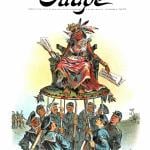Revelation 20:1-6 is perhaps one of the most contested passages in all of Scripture. It is certainly the most debated in the book of Revelation. Interpretations of Revelation 20:1-6 can be categorized into three main positions: premillennialism, postmillennialism, and amillennialism. The debate between these positions focuses on three exegetical issues: 1) Recapitulation and the relative time frame of Revelation 20:1-6 to what precedes it, 2) The nature of the binding of Satan, and 3) The nature of the first resurrection. Because many strong arguments for amillennialism come from outside the book of Revelation[1] amillennialists can be perceived as not dealing with the locus classicus of the millennium in detail. Therefore, I will focus my attention almost exclusively on Revelation 20 and show how it supports amillennialism.[2]
Simply put, the amillennial position is that Revelation 20:1-6 recapitulates and describes the period between the comings of Christ, the church age. Satan’s binding is not total but for a specific purpose and “the first resurrection” is spiritual and not physical. However, before we address these three issues, we must make some introductory comments on the genre of Revelation as a book, because this will play an integral role in helping us interpret Revelation 20.
Genre
Revelation is widely recognized among scholars as a combination of three different genres: prophetic (1:3), apocalyptic (1:1), and epistolary (1:3, 22:21). As a prophetic-apocalyptic-epistle, we should expect Revelation do deal with future events (including the second coming of Christ) in a symbolic way, yet be heard and kept by its original audience (1:3, 22:7). Vern Poythress has helpfully identified four levels of communication based on the genre of Revelation which bring much needed clarity to interpreters of the book.[3] The first level is the linguistic level – the words that John wrote. The second level is the visionary level – what John saw in his various visions. Third is the referential level – the historical referents of the various particulars John sees in his visions. Fourth is the symbolic level – what the imagery John uses actually says about the historical referent.
Because of its genre and levels of meaning, Revelation conveys meaning differently than historical narrative. Poythress notes that historical narratives speak directly of the events to which they refer and indirectly of the theology and significance of those events while symbolic literature does the opposite. Therefore, when we come to a symbolic vision we must be careful not to jump straight from the linguistic meaning to referential meaning leaving out the visionary and symbolic levels.
Recapitulation
Recapitulation is central to the structure of the book of Revelation. What “recapitulation” means is that John presents the same events between the first and second comings of Christ multiple times in in his book, each time from a different perspective and focusing more on the second coming. The easiest way to see recapitulation is to compare the language John uses to describe the judgment at the end of each section: 6:12-17, 11:13-19, 14:14-20, 16:17-21, 19:11-21, 20:7-10. A close examination of these passages will show that they all refer to the same event: the second coming of Christ and the final judgment. The question then becomes, does Revelation 20:1-6 recapitulate or progress from Revelation 19? Two lines of evidence make us think it recapitulates.
First, Revelation 20:2 records that the nations will be “bound” so that he might not deceive “the nations,” yet according to Revelation 19:11ff the nations are destroyed. Premillennialists will attempt to get around this by suggesting that the destruction in Revelation 19 is partial and not complete, yet that does not do justice to the comprehensive language that John employs, especially in 19:18, which lists, “Kings…captains…mighty men…horses and their riders…all men, both free and slave, small and great.” This language has strong parallels with 6:15, 11:18, 13:16, 19:5, and 20:12, all of which unambiguously describe either all believers (as in 11:18 and 19:15), all unbelievers (6:15, 13:16), and possibly all humanity (20:12). It would be quite unlike John to make such a list and use merisms such as “free and slave…small and great” to refer to only a selection of unbelieving humanity. Therefore, the presence of the nations in Revelation 20:1-6 indicates the presence of recapitulation.
Second, the battle John describes in 20:7-10 is the same battle he describes in 19:11ff. We know this for two reasons, first, John draws upon Ezekiel 38-39 to describe both battles. In 20:8 John makes unambiguous reference to “Gog and Magog,” and in 19:17-18 John nearly quotes Ezekiel 39:4, 17-20. It would be unusual for John to draw on the same OT passage in such close proximity to describe two different events. The second reason the battles in Revelation 19 and 20 are the same is the presence of the article before πόλεμος (war/battle). This is significant because it indicates that John is referring to a specific battle, one he has introduced already. When we look at the rest of Revelation we see that John introduces this “battle” in 11:7 and from that point onward refers to it as “the battle” in 16:14 and 19:19. Both these observations indicate that the battle of 19:11ff and 20:7-10 are the same battle and therefore 20:1-6 recapitulates and precedes 19:11ff temporally.
Binding of Satan
If we are correct, and Revelation 20 begins a new section of recapitulation, the interpreter has warrant to search for another meaning to the binding of Satan that does not entail his complete cessation from every activity on earth. When we look at how John describes Satan’s binding we must keep in mind Poythress’s levels of meaning – John is describing what he saw in a vision and we cannot jump straight from the visionary level to the referential level and bypass the symbolic level. It is my view that Satan’s binding describes the limitation of his activity by the sovereign God so that he might not deceive the nations into waging all-out war against the saints resulting in their destruction. The clearest indication of this is from a comparison of Revelation 20:3 and 20:8. In verse 3, Satan is bound “So that he might not deceive the nations” and in 20:8 he is released and goes out “to deceive the nations” with the result that they wage all-out war against the saints. We can see the character of the binding of Satan by looking at what happens when that binding is removed.
One potential problem for this view is the presence of the word ἔτι, commonly translated “no longer” and used to argue that Satan was engaging in his deceptive activity prior to the binding. Two responses are merited, first, the word ἔτι could also be translated “not yet” (1 Cor. 3:2). Second, even if one translates it as “no longer” it may fit with the amillennial position. Revelation 11 gives a strikingly similar picture to that of chapter 20. In chapter 11 John sees a vision of the spiritual protection of the church in order that they may witness faithfully on earth. When they have finished their witness the beast arises to make war on them, kill them, and deceive the nations. With this in view, the binding of Satan may not only to refer to his inability to gather the nations for war, but also to his inability to spiritually harm the saints during the church age so as to snuff out their light and prevent the gospel from going to all the nations.
First Resurrection
Amillennialists differ on the exact interpretation of the “first resurrection,” some interpret it as referring to regeneration and others as referring to the entrance of the souls of the saints into heaven upon their bodily death. The arguments I will present could support either view and I will leave it up to the reader to decide which fits best.
It is important to remind ourselves of Poythress’s levels of meaning as we approach the first resurrection. Revelation 20 is a series of visions, so while I fully agree that John saw (visionary) a physical, bodily resurrection and that the words he used speak of one (linguistic), that does not imply that the historical reality to which the vision refers (referential) is a bodily resurrection but may convey truth through the use of imagery (symbolic). Furthermore, the presence of recapitulation in Revelation 20 gives warrant for seeking this symbolic interpretation. Four arguments converge to support the amillennial position.
First, in Revelation, “thrones” refers to heavenly thrones, with two exceptions – 13:2 and 16:10 where it refers to the throne of the dragon and of the beast. Yet even in these two exceptions the thrones are spiritual, not physical. Therefore, to begin this verse with the assumption that John is describing a physical, earthly reign of the saints runs counter to the first piece of evidence.
Second, John has already described symbolic resurrections in Revelation 11:11 and 13:14. The first instance speaks of the vindication of the church and alludes to the valley of dry bones in Ezekiel 37:5, 10 by the use of the language “breath of life.” The second instance is clearly symbolic and refers to the counterfeit resurrection of the beast, i.e. the apparent defeat and revivification of wicked governments throughout history. But in both cases what John saw was a bodily resurrection. This means that John’s readers would have been sensitive to the symbolic use of resurrection imagery in Revelation.
Third, John’s use of Ezekiel in chapter 20 gives warrant for a symbolic interpretation of the phrase, “came to life” in 20:6a. Broadly speaking, Revelation 20-22 follows the outline of Ezekiel 37-48. Ezekiel sees a vision of a resurrected Israel (37), an eschatological battle with Gog and Magog (38:1-16, 39:1-4a), the defeat and judgment of Gog and Magog by Yahweh (38:17-23, 39:4b-24) followed by a consummate recreated temple (39:25-48) – the same order as Revelation 20-22. In this scheme Revelation 20:4-5 corresponds to Ezekiel’s vision of the valley of dry bones. Furthermore, the LXX of Ezekiel 37 uses the same Greek word as John (ζαω) five times to refer to the resurrection of the dry bones, including in verse 10 the exact same form John uses in 20:4-5, ἔζησαν. This observation gives significant credence to the amillennial position that interprets John’s vision symbolically when he says, “they came to life.”
Fourth, Meredith Kline has argued that the presence of the word “first” (πρῶτος) in 20:6 provides warrant for interpreting the word “resurrection” (ἀνάστασις) as referring symbolically to something other than a bodily resurrection. He points to the use of “first” in 21:4 to argue that it means more than just chronological priority, but refers to the current, earthly order in contrast to the “new” consummated order in 21:1. He also argues that a “first” resurrection implies a “second” resurrection and a “second” death implies a “first” death. The “second” death refers symbolically to the unbelievers resurrection unto judgment and the “first” death refers to earthly, bodily death. The “second” resurrection refers to the bodily, consummate resurrection and the “first” resurrection refers to a pre-consummate resurrection, be that regeneration or the spirit’s entrance into heaven upon death. In both cases “first” implies a temporary and pre-consummate state and “second” implies a consummate and eternal state – therefore we should not interpret “the first resurrection” as the bodily, consummate, and eternal resurrection.
Conclusion
I hope to have at least convinced you that amillennialism is not without exegetical support from Revelation 20. I have left out many arguments as well as many critiques of the other views. For brief critiques of other views see my response to the companion articles, for further arguments for amillennialism, see the “Further Reading” list below.
Further Reading:
Overall
Beale, G. K. “The Millennium in Revelation 20:1-10: An Amillennial Perspective.” Criswell Theological Review, Fall 2013: 29-62.
On Genre
Poythress, Vern Sheridan. “Genre and Hermeneutics in Rev 20:1-6.” Journal of the Evangelical Theological Society, 1993: 41-54.
On Recapitulation
White, R. Fowler. “Reexamining the Evidence for Recapitulation in Rev 20:1-10.” Westminster Theological Journal, Fall 1989: 319-344.
On the Binding of Satan
White, R. Fowler. “On the Hermeneutics and Interpretation of Rev 20:1-3: A Preconsummationist Perspective.” Journal of the Evangelical Theological Society, 1999: 53-68.
On the First Resurrection
Kline, Meredith G. “The First Resurrection.” Westminster Theological Journal, Spring 1975: 366-375.
[1] Including the fulfillment of Isaiah 25:8 in at the resurrection 1 Corinthians 15:54 and in Revelation 21:4 at the consummation, thereby precluding a 1000 year gap between the resurrection and the consummation.
[2] I have written a fuller defense of the amillennial exegesis of Revelation 20 here.
[3] Poythress, Vern Sheridan. “Genre and Hermeneutics in Rev 20:1-6.” Journal of the Evangelical Theological Society, 1993, p. 41-42.












